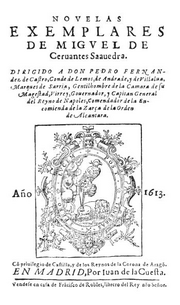Rinconete y Cortadillo facts for kids
Quick facts for kids "Rinconete y Cortadillo" |
|
|---|---|

1613 book cover
|
|
| Author | Miguel de Cervantes |
| Original title | "Novela de Rinconete y Cortadillo" |
| Country | Spain |
| Language | Spanish |
| Genre(s) | Picaresque short story |
| Published in | Novelas Ejemplares |
| Publication date | 1613 |
| Preceded by | "El amante liberal" |
| Followed by | "La española inglesa" |
Rinconete y Cortadillo is a fun short story by the famous Spanish writer Miguel de Cervantes. It is one of twelve stories found in his book Novelas Ejemplares (which means Exemplary Novels). This story follows the funny adventures of two clever young boys as they travel to the city of Seville. They soon join a special group of tricksters in the city. At that time, Seville was a very rich city, known as a major trading hub between Spain and the Americas.
Contents
The Story of Rinconete and Cortadillo
Meeting on the Road
The story begins when two young boys, named Rincón and Cortado, meet at an inn by the side of a road. They start talking and quickly realize they are both "pícaros." A pícaro is a clever, wandering young person who lives by their wits and plays tricks to get by.
Adventures in Seville
Rincón and Cortado proudly share stories of how they have tricked other travelers. They decide to travel together to Seville, a big and busy city. In Seville, their small tricks and clever ways catch the attention of a secret group of tricksters.
Joining the Group
This group of tricksters is led by a man named Monipodio. Rincón and Cortado are invited to join his group. In the second part of the story, the boys watch how this group is organized. They see all the funny and strange things the members do.
New Names
To show that Rincón and Cortado are now part of his group, Monipodio gives them new, friendly nicknames. Rincón becomes "Rinconete," and Cortado becomes "Cortadillo." These are the names that give the story its title. The story shows the boys' journey and their funny experiences with this unique group.
About the Author and the Story
Who Wrote It?
Rinconete y Cortadillo was written by Miguel de Cervantes. He is one of Spain's most famous writers, best known for his novel Don Quixote. Cervantes mentioned this story by name in Don Quixote when it was published in 1605.
When Was It Published?
Even though Cervantes mentioned the story in 1605, Rinconete y Cortadillo was officially published later. It appeared in his collection Novelas Ejemplares in 1613. For a long time, people have discussed how this story came to be. Some old copies of the story were found that made people wonder if someone else had written it.
Cervantes's Connection
However, most experts today agree that Cervantes is the true author. His writing style and the way he tells the story are very clear. Some scholars believe Cervantes might have first planned to include this story inside Don Quixote itself, but later decided to publish it separately.
See also
 In Spanish: Rinconete y Cortadillo para niños
In Spanish: Rinconete y Cortadillo para niños

